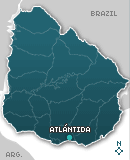Tours and Activities:
Gold Dust
Pablo Etchevers Pablo Etchevers“Costa de Oro” (Gold Coast) is the name given to the great variety of beaches stretching from La Barra de Carrasco, in Montevideo, to Solís Grande Creek, in the District of Jaureguiberry.

Is it possible to determine an exact point in the map where the Río de la Plata ceases to be a river and turns into a sea? How can the water change from fresh to salty according to the direction in which the wind blows? When are we speaking about the sea and when about the river in geographical terms? All these questions have been made once and again by those who spend the summer in Uruguay.
The truth is that to the North of the City of Montevideo the water begins to abandon the typical lion color of the Río de la Plata to turn green at first sight and then blue and also to increase its salinity.

The beaches spanning from La Barra de Carrasco up to the proximities of the City of Piriápolis are referred to as Costa de Oro (Gold Coast). Here, it is possible to observe how the river turns into the sea to be declared ocean at the City of Punta del Este.
The Gold Coast
The City of Atlántida is the capital of the Costa de Oro area. Other important cities are Neptunia and Costa Azul, followed by smaller districts like Las Toscas, Parque del Plata, La Floresta and Jaureguiberry, where Solís Grande Creek sets the end of these beaches.

Before reaching Piriápolis, the Ruta Interbalnearia (Inter-beach Road) displays small villages which have been built in front of the sea with their own codes and customs and, of course, have conquered their own summer visitors and followers. The list seems endless. Starting at the South and towards the North, the villages are Barra de Carrasco, Parque de Carrasco, Shangrillá, San José de Carrasco, Lagomar, El Bosque, Solymar, San Cristóbal, Pinar, Neptunia, Salinas, Pinamar, Marindia, Fortín de Santa Rosa, Villa Argentina, Atlántida, Las Toscas, Parque del Plata, La Floresta, Costa Azul, Bello Horizonte, Guazú Vira, San Luis, Los Titanes, La Tuna, Araminda, Santa Lucía del Este, Biarritz, Cuchilla Alta, Santa Ana, Balneario Argentino and, last but not least, Jaureguiberry.

They are a must visit. Many visitors usually start their tour at Atlántida, whether northwards or southwards, to come across the various features. Solitary sandy beaches, some of them sprinkled by large rock formations that give shape to natural pools ideal for fishing. Others, crowded with swimmers in search for cool waters, as they shelter in the shade of the huge pine trees planted by man to fill these resorts with oxygen.
These beaches offer countless alternatives and, though this article does not provide any answer to the initial question of where the river ends and the sea begins, or vice versa, the truth is that the Costa de Oro does exist for each visitor to find their place in the world.

© 2007-2025 Total or partial reproduction forbidden. Derechos de Autor 675244 Ley 11723


 See also:
See also: 



